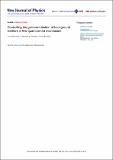Files in this item
Controlling the gain contribution of background emitters in few-quantum-dot microlasers
Item metadata
| dc.contributor.author | Gericke, F | |
| dc.contributor.author | Segnon, M | |
| dc.contributor.author | von Helversen, M.M. | |
| dc.contributor.author | Hopfmann, M | |
| dc.contributor.author | Heindel, T | |
| dc.contributor.author | Schneider, C | |
| dc.contributor.author | Höfling, Sven | |
| dc.contributor.author | Kamp, M | |
| dc.contributor.author | Musiał, A | |
| dc.contributor.author | Porte, X | |
| dc.contributor.author | Gies, C | |
| dc.contributor.author | Reitzenstein, S | |
| dc.date.accessioned | 2018-02-19T17:30:06Z | |
| dc.date.available | 2018-02-19T17:30:06Z | |
| dc.date.issued | 2018-02 | |
| dc.identifier | 251867578 | |
| dc.identifier | 783583b4-d2da-4f1f-a606-3b88e79462c2 | |
| dc.identifier | 85043465128 | |
| dc.identifier | 000425349000004 | |
| dc.identifier.citation | Gericke , F , Segnon , M , von Helversen , M M , Hopfmann , M , Heindel , T , Schneider , C , Höfling , S , Kamp , M , Musiał , A , Porte , X , Gies , C & Reitzenstein , S 2018 , ' Controlling the gain contribution of background emitters in few-quantum-dot microlasers ' , New Journal of Physics , vol. 20 , 023036 . https://doi.org/10.1088/1367-2630/aaa477 | en |
| dc.identifier.issn | 1367-2630 | |
| dc.identifier.uri | https://hdl.handle.net/10023/12753 | |
| dc.description | Funding: European Research Council under the European Union's Seventh Framework ERC Grant Agreement No. 615613; German Research Foundation via Grant-No.: Re2974/10-1, Gi1121/1-1. | en |
| dc.description.abstract | We provide experimental and theoretical insight into single-emitter lasing effects in a quantum dot (QD)-microlaser under controlled variation of background gain provided by off-resonant discrete gain centers. For that purpose, we apply an advanced two-color excitation concept where the background gain contribution of off-resonant QDs can be continuously tuned by precisely balancing the relative excitation power of two lasers emitting at different wavelengths. In this way, by selectively exciting a singleresonant QD and off-resonant QDs, we identify distinct single-QD signatures in the lasing characteristics and distinguish between gain contributions of a single resonant emitter and a countable number of offresonant background emitters to the optical output of the microlaser. Our work addresses the importantquestion whether single-QD lasing is feasible in experimentally accessible systems and shows that, for the investigated microlaser, the single-QD gain needs to be supported by the background gain contribution ofoff-resonant QDs to reach the transition to lasing. Interestingly, while a single QD cannot drive the investigated micropillar into lasing, its relative contribution to the emission can be as high as 70% and it dominates the statistics of emitted photons in the intermediate excitation regime below threshold. | |
| dc.format.extent | 14 | |
| dc.format.extent | 2578192 | |
| dc.language.iso | eng | |
| dc.relation.ispartof | New Journal of Physics | en |
| dc.subject | Nanolasers | en |
| dc.subject | Cavity QED high-beta lasing | en |
| dc.subject | Quantum dot micropillar cavities | en |
| dc.subject | Single quantum dots laser | en |
| dc.subject | Semiconductor laser | en |
| dc.subject | QC Physics | en |
| dc.subject | TK Electrical engineering. Electronics Nuclear engineering | en |
| dc.subject | NDAS | en |
| dc.subject.lcc | QC | en |
| dc.subject.lcc | TK | en |
| dc.title | Controlling the gain contribution of background emitters in few-quantum-dot microlasers | en |
| dc.type | Journal article | en |
| dc.contributor.institution | University of St Andrews. School of Physics and Astronomy | en |
| dc.contributor.institution | University of St Andrews. Condensed Matter Physics | en |
| dc.identifier.doi | https://doi.org/10.1088/1367-2630/aaa477 | |
| dc.description.status | Peer reviewed | en |
This item appears in the following Collection(s)
Items in the St Andrews Research Repository are protected by copyright, with all rights reserved, unless otherwise indicated.

